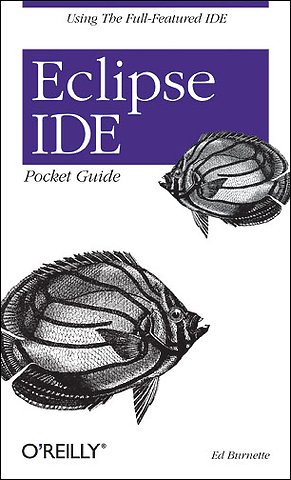Eclipse IDE Pocket Guide
Paperback Engels 2005 9780596100650Samenvatting
Eclipse is the world's most popular IDE for Java development. And although there are plenty of large tomes that cover all the nooks and crannies of Eclipse, what you really need is a quick, handy guide to the features that are used over and over again in Java programming. You need answers to basic questions such as: Where was that menu What does that command do again And how can I set my classpath on a per-project basis
This practical pocket guide gets you up to speed quickly with Eclipse. It covers basic concepts, including Views and editors, as well as features that are not commonly understood, such as Perspectives and Launch Configurations. You'll learn how to write and debug your Java code--and how to integrate that code with tools such as Ant and JUnit. You'll also get a toolbox full of tips and tricks to handle common--and sometimes unexpected--tasks that you'll run across in your Java development cycle.
Additionally, the Eclipse IDE Pocket Guide has a thorough appendix detailing all of Eclipse's important views, menus, and commands.
The Eclipse IDE Pocket Guide is just the resource you need for using Eclipse, whether it's on a daily, weekly, or monthly basis. Put it in your back pocket, or just throw it in your backpack. With this guide in hand, you're ready to tackle the Eclipse programming environment.
Specificaties
Lezersrecensies
Inhoudsopgave
Chapter 1: Introduction;
1.1 What Is Eclipse?;
1.2 Conventions Used in This Book;
1.3 System Requirements;
1.4 Downloading Eclipse;
1.5 Installing Eclipse;
1.6 Exploring Eclipse;
1.7 Getting Upgrades;
1.8 Moving On;
Chapter 2: Workbench 101;
2.1 Views;
2.2 Editors;
2.3 Menus;
2.4 Toolbars and Coolbars;
2.5 Perspectives;
2.6 Rearranging Views and Editors;
2.7 Maximizing and Minimizing;
Chapter 3: Java Done Quick;
3.1 Creating a Project;
3.2 Creating a Package;
3.3 Creating a Class;
3.4 Entering Code;
3.5 Running the Program;
Chapter 4: Debugging;
4.1 Running the Debugger;
4.2 Setting Breakpoints;
4.3 Single Stepping;
4.4 Looking at Variables;
4.5 Changing Code on the Fly;
Chapter 5: Unit Testing with JUnit;
5.1 A Simple Factorial Demo;
5.2 Creating Test Cases;
5.3 Running Tests;
5.4 Test First;
Chapter 6: Tips and Tricks;
6.1 Code Assist;
6.2 Templates;
6.3 Automatic Typing;
6.4 Refactoring;
6.5 Hover Help;
6.6 Hyperlinks;
6.7 Quick Fixes;
6.8 Searching;
6.9 Scrapbook Pages;
6.10 Java Build Path;
6.11 Launch Configurations;
Chapter 7: Views;
7.1 Breakpoints View;
7.2 Console View;
7.3 Debug View;
7.4 Declaration View;
7.5 Display View;
7.6 Error Log View;
7.7 Expressions View;
7.8 Hierarchy View;
7.9 Javadoc View;
7.10 JUnit View;
7.11 Navigator View;
7.12 Outline View;
7.13 Package Explorer View;
7.14 Problems View;
7.15 Search View;
7.16 Tasks View;
7.17 Variables View;
Chapter 8: Short Takes;
8.1 CVS;
8.2 Ant;
8.3 Web Tools Platform;
8.4 Testing and Performance;
8.5 Visual Editor;
8.6 C/C++ Development;
8.7 AspectJ;
8.8 Plug-in Development;
8.9 Rich Client Platform;
8.10 Standard Widget Toolkit;
Chapter 9: Help and Community;
9.1 Online Help;
9.2 Eclipse Web Site;
9.3 Community Web Sites;
9.4 Reporting Bugs;
9.5 Newsgroups;
9.6 Mailing Lists;
9.7 Conclusion;
Appendix A: Commands;
A.1 Edit Commands;
A.2 File Commands;
A.3 Help Commands;
A.4 Navigate Commands;
A.5 Perspective Commands;
A.6 Project Commands;
A.7 Refactor Commands;
A.8 Run/Debug Commands;
A.9 Search Commands;
A.10 Source Commands;
A.11 Text-Editing Commands;
A.12 View Commands;
A.13 Window Commands;
Rubrieken
- advisering
- algemeen management
- coaching en trainen
- communicatie en media
- economie
- financieel management
- inkoop en logistiek
- internet en social media
- it-management / ict
- juridisch
- leiderschap
- marketing
- mens en maatschappij
- non-profit
- ondernemen
- organisatiekunde
- personal finance
- personeelsmanagement
- persoonlijke effectiviteit
- projectmanagement
- psychologie
- reclame en verkoop
- strategisch management
- verandermanagement
- werk en loopbaan

